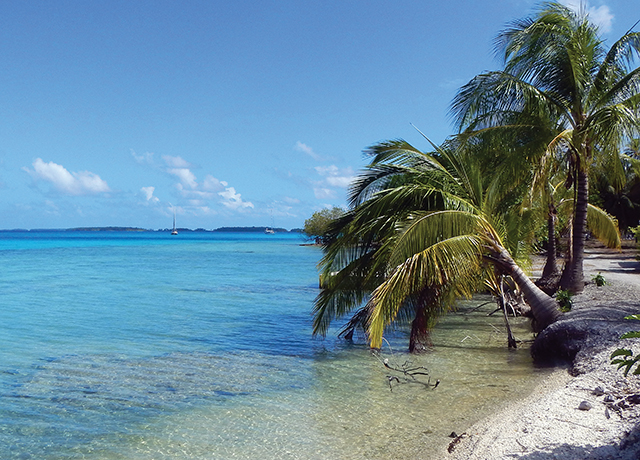Discovering Penrhyn atoll in the Cook Islands starts by learning where it is (published March 2015)
Type “Penrhyn” into Google and you’ll get back a list of things to do in a small town in North Wales, UK. When we were in Bora Bora, South Pacific, that wasn’t much help in choosing the next destination for our extended cruise around the world.
But type in “Penrhyn Cook Islands”, and a whole different set of information is returned: remote, windswept, friendly villagers, pipi pearls. These were all words that piqued our interest in finding out more.
My husband Neville and I have been cruising on our Hallberg-Rassy 42, Alba, since April 2011. Starting in Grenada, we sailed to the West Indies, ABC islands, East Coast of the U.S. as far north as Maine, Cuba, Belize, Jamaica, Panama and Ecuador, with a couple of side trips up the isolated Manamo River in Venezuela and equally remote Darien region in Panama. And we plan on spending the next five or six years completing the circumnavigation back to Grenada via New Zealand, Indonesia, South Africa and Brazil. We are in no rush, so discovering a little place like Penrhyn was perfect for our schedule.
FINDING PENRHYN
We came upon Penryhn, a place we didn’t previously know existed, quite by accident. We had planned to sail from Bora Bora to Samoa, while stopping off at Suwarrow Atoll, Cook Islands on the way for a week or so.
However, the GRIB files for the next week showed very strong easterly winds at 30 to 35 knots and lots of rain in a wide band for the whole of the southern and most of the northern Cook Islands, including Suwarrow. Farther north, the winds were forecast to be lighter with clearer skies.
Looking for anywhere farther north than Suwarrow that we could reasonably sail to, we zoomed in on the Navionics chart and a little 10-by-7-mile piece of ocean 580 miles northwest of Bora Bora turned into land. It was Penrhyn Atoll. With wind predicted at 15 knots from the east, we could sail on a comfortable broad reach and be there in four to five days. Our decision was made.
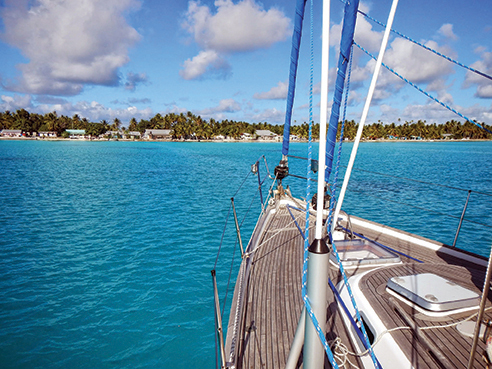
Five days later, after almost perfect sailing conditions, we motored through the pass into Penrhyn’s lagoon. There were breaking reefs on either side of the entrance and a short dogleg to negotiate on the way in. But in good light it went well and because supply ships occasionally visit the atoll, there was plenty of depth.
LOCAL KNOWLEDGE
There are two villages on Penrhyn. On the western side of the atoll is Omoka, which is the larger of the two and has about 150 inhabitants. There is a bank, a bakery, a post office and two shops, but one is nearly always closed and the other is inconveniently located two miles away.
The other village, Te Tautua, with 50 plus residents and no shops, banks, bars or otherwise, is on the eastern side of the atoll. This was where we planned to spend most of our time, as the constant trade winds blowing across seven miles of uninterrupted lagoon cause an unpleasant chop in the Omoka anchorage and the lee shore behind the boat was disconcertingly close.
We waited in Omoka for the Quarantine and Health official to come aboard to bug spray the boat and sign a form declaring that we were now free to go ashore. He introduced himself as Tuku Marsters, and proudly declared himself a descendant of the Englishman William Marsters, who around 1860 took on three wives and did his best to populate both the islands of Palmerston and Penrhyn. During our stay on Penrhyn we came to know many people whose names either began or ended with Marsters or Williams, or any combination of the two.
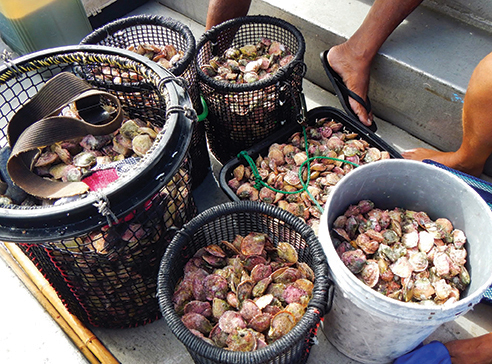
Walking around the village of Omoka, we came across a house whose yard was strewn with small, shiny yellow shells. The owner, noticing our interest in them, beckoned us over, introduced himself as William Marsters and told us they were pipi shells.
This is the only place in the world where pipi pearls are found. The shells are about two inches square and grow abundantly in the lagoon. Occasionally, a pearl will be found inside, the most prized having a warm golden luster. They can be minute, the size of a full stop, up to 6 or 7 mm. These larger pearls are very rare and might fetch up to 2,000 NZD ($1,500) each.
For residents of Penrhyn, earning an income is hard. The price of copra has fallen to such a degree that it’s not worthwhile to work at a coconut plantation, and there is certainly no shortage of coconut trees here. Likewise, no black pearls are farmed any more, either, because the lagoon suffered a virus some years ago that caused the oysters to die off.
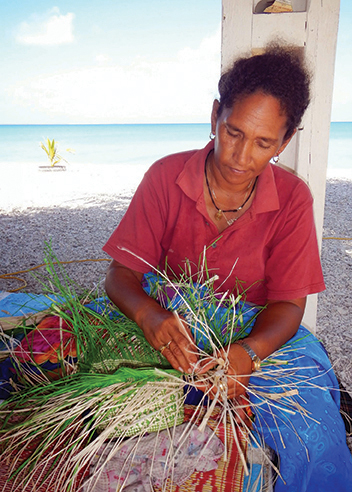
Rito hats are still woven by some of the ladies and are sent to Rarotonga for sale there. They are exquisitely made with dried and dyed palm fronds; the more intricate ones can command prices of at least 150 NZD ($100). But most of the people are focused on collecting pipi pearls as a means of making money. Several buyers were due to arrive later in the year, so there was a flurry of boats going out each day to gather shells.
ISLAND LIFE
After our brief excursion round the village of Omoka, we motored east across the lagoon to the other village, Te Tautua. On the way, we wondered how many boats would already be there. (Looking through the island’s yacht visitors book a few days later, we noted that we were only the ninth boat to visit this year). As we approached the anchorage, we saw two yachts lying quietly at anchor in clear, calm water over soft, white sand. And a couple of black-tipped reef sharks circled idly around. The lagoon is full of them, the kids ashore play in the shallows with them, and we always had a few to accompany us when we went snorkeling.
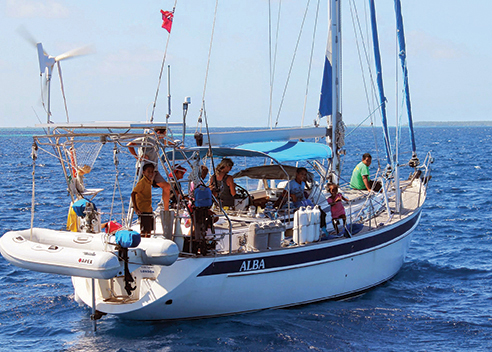
As soon as the anchor was dug in and our own family of black-tips set up residence under the keel, David from Laragh hailed us on the VHF to say, “Welcome to Te Tautua. We’re ashore in the big grey building. Bring your toolbox with you.”
He and Paul from The Beguine were busy fixing a few problems with the village truck. The starter motor had not worked for over a year and the lights were permanently on unless the battery was disconnected.
Our first week flew by in a blur of helping to fix things ashore—computers, printers, a generator, microwave (this was a lost cause), and a broken flagpole. People here are hard on equipment, but when no supplies arrive for months on end, they have to make do with what’s at hand. And for at least one week, they had the resources of three yachts to call upon.
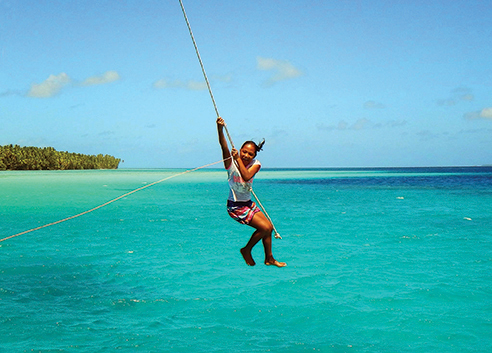
Of course, nobody worked on Sundays. This is a day for going to church, eating and resting. No use of machinery, playing musical instruments, going out in boats or even swimming is allowed. The only concession for us using the dinghy was to come ashore to go to church. Attendance at the Cook Islands Christian Church was neither compulsory nor pushed upon us, but Neville and I really wanted to take part in such an important part of the community’s life.
There are three services on Sunday, 6:30 a.m., 10 a.m. and 2 p.m., and everyone attends all of them. Dress code for men is a collared shirt and long trousers, and flips flops are acceptable. For women, it is a blouse covering the shoulders, a skirt below the knees and a hat. Nev and I opted for the 10 a.m. service, but slipped into Sunday School beforehand to listen to the children and adults practicing their hymns. The singing is amazing, with such harmonies and feeling put into the music. We were allowed to record the singing in Sunday School, but recording or photographing inside the church is strictly forbidden.
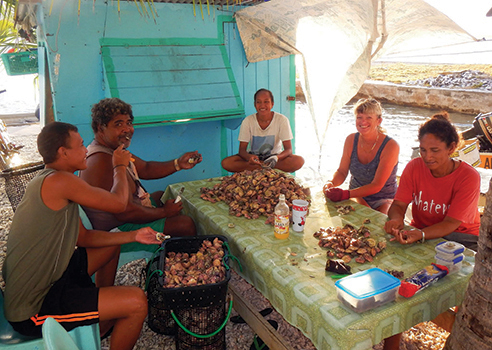
FAST FRIENDS
We didn’t go ashore every day, sometimes it was nice to chill out on the boat by ourselves, drink a few beers (none of the villagers were interested in consuming alcohol) and do Internet stuff. Surprisingly, the Internet connection was very good. Even though Penrhyn is remote, the people are still up to date with the latest technology—everyone Skyped family and friends in New Zealand and Australia, texted one another, and uploaded photos to Facebook that they’d taken on their iPads.
We kept the VHF on all the time and accepted unexpected calls for adventure from our new friends, “Anyone want to go fishing tonight?” “We’ve just shot four wild pigs, care to join us for a meal?” “We’re going pipi collecting tomorrow. Is 10 o’clock OK with you guys?” Of course, we said yes to everything.
We also said yes to a big trip to a motu (island) farther down the atoll where the villagers wanted to take their kids to camp overnight. It was arranged that the three yachts would transport all the people and tow their aluminium boats behind, packed with camping and cooking gear. What a blast! There were at least 12 adults and kids per yacht and everyone was excited to be sailing along, laughing, singing and taking photos.
Camp was soon set up and cook fires were prepared for the evening meal. The place was a hive of activity—men husking and grating coconuts and filleting freshly-caught fish, women steaming taro dumplings, marinating fish in coconut cream and frying others in a huge pan. We were in for a feast!
Several long trestle tables were laden with food, and as on previous occasions, the cruisers were asked to sit and eat first. Initially, we found it hard to eat while the local people sat patiently waiting their turn, but we soon came to accept it as another example of their unassuming hospitality and generosity towards strangers. That weekend was one of the highlights of our stay in Penrhyn.
SAD GOODBYES
The days turned into weeks. Laragh left, followed a week later by The Beguine and before we knew it, it was time for us to leave as well. We had been in Penrhyn for nearly a month and stocks were looking pretty thin—no beer, wine, Coke, eggs, cheese, fresh fruit or vegetables—and we had a seven day trip to Samoa ahead of us.
We went ashore one final time to say our goodbyes. Mother of pearl shell necklaces were placed around our necks as a parting gift and coconuts and breadfruit were pressed into our hands for the journey. It was all rather emotional.
The Samoan name for Penrhyn is Tongareva, meaning “Tonga floating in space.” But the GPS coordinates place it more down to earth at 8˚ 58 S, 157˚ 58 W. It is 1,820 miles straight south of Honolulu, 2,240 miles northeast of Auckland and 8,840 miles from Penrhyn, North Wales.
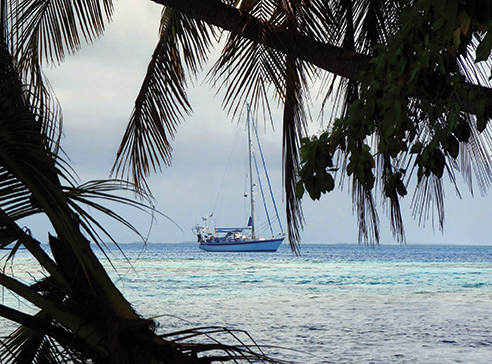
Even if you don’t get a chance to visit this remote, windswept island with oh-so-friendly people, at least now you have no excuse for not knowing where it is like we did.
Tired of being in the world of work, mortgages and long distance driving, Glenys and Neville Howarth retired at the age of 54. They sold their house and possessions in the UK, bought a boat in Grenada that they had never seen (apart from in photos), and moved onto it in April 2011 with just two bags each. They are currently in New Zealand, approximately one third of the way into their circumnavigation.

















